If GMAT sections were characters in a movie, Multi-Source Reasoning (MSR) would be that mysterious detective – armed with layers of information, unexpected plot twists, and a love for logic.
So, what exactly is MSR? It’s part of the Data Insights section of the GMAT Focus Edition – and according to GMAC, over 80% of test-takers find DI questions more challenging than Quant. Why? Because MSR demands that you juggle multiple sources of data – texts, tables, charts – while staying cool, focused, and strategic. Basically, it's like solving a mystery with three tabs open and a timer ticking. Fun, right?
But here's the good news: mastering MSR isn’t about being a genius; it’s about thinking like a detective. And like Sherlock Holmes, once you have a method, the chaos becomes... elementary.
Through this blog, we’ll break down the MSR beast into bite-sized strategies, throw in a few laughs (because let’s face it, you’ll need them), and show you how to turn stress into strategy. Because MSR isn’t just about data – it’s about how you make decisions when things get tricky.
What Exactly Is Multi-Source Reasoning?
Think of Multi-Source Reasoning (MSR) as the GMAT’s way of testing how well you can connect the dots when information is spread out across different sources — like flipping between emails, charts, and reports before making a smart decision.
You’re basically being asked: “Can you find what matters... when everything looks like it matters?”
The Structure
1. Multiple Tabs – Like a Real-Life Dashboard:
You’ll be given 2 or 3 tabs, each with a different kind of info — maybe one has a company memo, another a sales chart, and the third a customer feedback log. You’ll need to hop between these tabs (yep, just like you do in real life) to answer a set of 2–3 questions.
2. Different Question Styles:
- Multiple-choice (1 correct answer): Straightforward, just pick the best option.
- Multiple-answer (e.g., 2 out of 5): A bit more challenging — get them both right or score zero.
- Table-style (Yes/No or True/False): For each row, you decide what’s supported by the data.
3. One Small Catch – No Partial Credit:
Yup, the GMAT is a bit ruthless here. You get full credit only if you answer everything correctly in a question. So, no “close enough” points. But hey, that’s why we’re practicing!
4. What Kind of Info?
Expect a mix of words and numbers. It could be:
- Written content (emails, letters, short reports)
- Visual data (tables, graphs, charts)
- Or a combo that tries to confuse you — but don’t worry, you’ll outsmart it.
Types of Information You’ll See in MSR Questions
In MSR questions, the GMAT throws different types of content at you — kind of like a group project where everyone speaks a different language. Your job? Translate it all into smart, fast decisions.
Here are the usual suspects:
1. Text-Based Information
You might get emails, memos, reports, or company updates. Sometimes it’s friendly; sometimes it’s dry. Either way, read with purpose — not every word matters.
Skim first, then zoom in when a question points to a specific detail.
2. Tables
Tables are used to compare data — sales figures, survey results, financial summaries. The trick is to find trends, outliers, or relationships between values.
Sort out what the rows and columns actually mean before diving in.
3. Graphs (Bar, Line, Pie – the Whole Buffet)
Graphs visually represent data trends over time, between categories, or among groups. They’re there to help you spot patterns fast — so don’t overthink the visuals.
Double-check the axes and labels before jumping to conclusions. GMAT loves a sneaky scale!
4. Diagrams or Flowcharts (Rare, But Possible)
Sometimes you might see a process chart or workflow – kind of like a “who does what and when” graphic. These test your ability to follow a sequence or decision path logically.
Follow arrows or steps carefully — there’s usually a logical trap waiting for the rushed reader.
Common MSR Question Formats
1. True/False Question Example
Scenario:
You are given two tabs: one has a sales report for a product line over the last quarter, and the other contains a memo discussing the new marketing strategy.
Statement:
"The sales for the product line increased by 10% compared to the previous quarter."
Answer:
To determine whether this is true or false, you would need to check the sales report to see if the sales data shows a 10% increase.
If the report shows a 10% increase in sales, the statement is True.
If the report shows less or more than a 10% increase, the statement is False.
2. Multiple-Choice Question (One Correct Answer) Example
Scenario:
You are provided with three tabs: a chart showing customer satisfaction ratings, a memo explaining recent changes to customer service protocols, and a summary report that outlines feedback from a customer survey.
Question:
Which of the following statements is most accurately supported by the data provided?
A) Customer satisfaction has increased significantly after the new protocol was implemented.
B) Customer satisfaction remained stable throughout the quarter.
C) Customer satisfaction decreased due to staff changes in the customer service department.
D) The new protocol did not affect customer satisfaction.
Answer:
To answer this, you would compare the chart showing customer satisfaction with the memo detailing the new protocol. Based on the changes described and the data on customer satisfaction, you would choose the correct statement.
If the chart shows an increase in satisfaction after the new protocol was implemented, you would select A.
If none of the options seem to perfectly match the data, eliminate clearly incorrect answers and focus on the one that is best supported by the data.
3. Yes/No Question Example
Scenario:
You are given two tabs: a data table showing sales figures for each region and a memo describing the performance targets for each sales team.
Question:
"Did the Western region meet its sales target for the quarter?"
Answer:
You would check the data table for the sales figures of the Western region and compare it with the target stated in the memo.
If the sales figures for the Western region meet or exceed the target, the answer is Yes.
If the sales figures fall short of the target, the answer is No.
Sure! Here's a clean and concise table listing common challenges in GMAT Multi-Source Reasoning (MSR) questions along with effective strategies to overcome each:
Common Challenges & Effective Strategies
| Challenge | Why It’s a Problem | Effective Strategy |
|---|---|---|
| Information Overload | Multiple tabs with lots of data can feel overwhelming. | Skim all tabs first to understand the type of info in each. Don’t try to read everything in detail upfront. |
| Switching Between Tabs | Constantly jumping tabs can waste time and cause confusion. | Take quick notes or mentally tag what’s in each tab to reduce back-and-forth. Use strategic tab-switching. |
| Irrelevant Information | Some details are just there to distract you. | Focus only on what the question is asking. Ignore unrelated data. |
| Time Management | Spending too long on one set can eat into time for others. | Set a soft limit (e.g., 2 minutes per MSR question). Move on if you’re stuck, come back later if time allows. |
| Complex Wording | Questions can be wordy or confusing. | Rephrase the question in your own words. This helps clarify what it’s really asking. |
| No Partial Credit | One wrong choice = zero points, even if the rest are right. | Double-check each part of multi-answer or table questions before submitting. Accuracy matters more than speed here. |
| Misinterpreting Graphs/Tables | Misreading axes, legends, or data points leads to wrong answers. | Always read labels and units carefully before analyzing graphs or tables. Watch for sneaky tricks. |
| Overanalyzing | Trying to “find” something that’s not there wastes time. | Trust the data. If it doesn’t support the claim, move on. Don’t second-guess clear evidence. |
Absolutely! Here are some practical and human-friendly time management techniques tailored specifically for GMAT Multi-Source Reasoning (MSR) questions — because let’s be real, it’s easy to get lost in those tabs!
Time Management Techniques
| Technique | Why It Helps | How to Use It |
|---|---|---|
| Preview the Tabs First (30 seconds max) | Prevents information overload and saves scrolling time later. | Spend 20–30 seconds scanning all tabs to see what kind of content you're working with (emails, charts, tables, etc.). Don’t deep dive — just get the layout. |
| Skim Before You Solve | Helps avoid reading everything line by line. | Read the question first, then go find only the relevant data. Don’t waste time decoding all the tabs if the question only relates to one! |
| Set a Mental Timer (~2 mins per question) | Keeps you from over-investing in one question and running out of time for others. | MSR has 2–3 questions per set. Try not to spend more than 5–6 minutes total per MSR set. If one question is taking too long — flag it, guess, and move on. |
| Mark & Move | Avoids getting stuck on tough questions. | If you’re unsure, make an educated guess, mark the question (if using practice software), and come back if time permits. |
| Use Keyboard Shortcuts (for Online Test) | Saves seconds that add up. | Learn tab navigation and selection shortcuts for GMAT’s online interface (like Tab, Arrow keys, etc.). Efficiency matters. |
| Practice Under Timed Conditions | Builds your real-test stamina. | During prep, simulate test pressure. Use a stopwatch to mimic 6–8 mins per MSR set, not just open-ended practice. |
| Avoid Double-Checking Everything | Not every question needs a deep audit. | Trust your reasoning unless something seems clearly off. Prioritize accuracy, but don't obsess. |
Practice Question Set 1
Use the following e-mail correspondence to answer questions
E-mail from the Convention Coordinator
Our upcoming comic book convention is running into a few unexpected snags, the most pressing of which is that we appear to have seriously under estimated likely attendance. Our idea to promote the attendance of indus try professionals (who do not pay an attendance fee, once they are credentialed) by allowing them to bring along two guests is now threaten ing to cause us to overflow our assigned space in the convention center. There is an additional space available during the three days of the conven tion, but acquiring it would threaten our ability to pay our vendors and force us to rely on greater-than-anticipated volunteer assistance.
E-mail from the Convention Budget Officer
The change in guest policy has created a real problem then. We have cur rently budgeted $35,000 for three days to cover a wide array of vendor services, including security, transportation, and on-site medical personnel in the event of an accident or sudden illness. It has already been very diffi cult to find professionals who are both qualified and available to take on many of those skilled responsibilities. Worse, securing the use of expanded convention center space will cost an additional $7,000 over the long week end, cutting into our already tight overall budget. Indeed, any additional expenditures will require the use of yet more (potentially underqualified) volunteers.
E-mail from the Events Coordinator of the Convention Center
We have considered your proposal for expanded use of the convention cen ter facilities and (given the expected size of the convention’s attendance) are prepared to let you lease the additional space at a 40% discount. More, the center is willing to offer you the use of its own security personnel, though only for Friday and Saturday (which together are expected to see far more traffic than Sunday), and only if you agree to also take on the additional convention space.
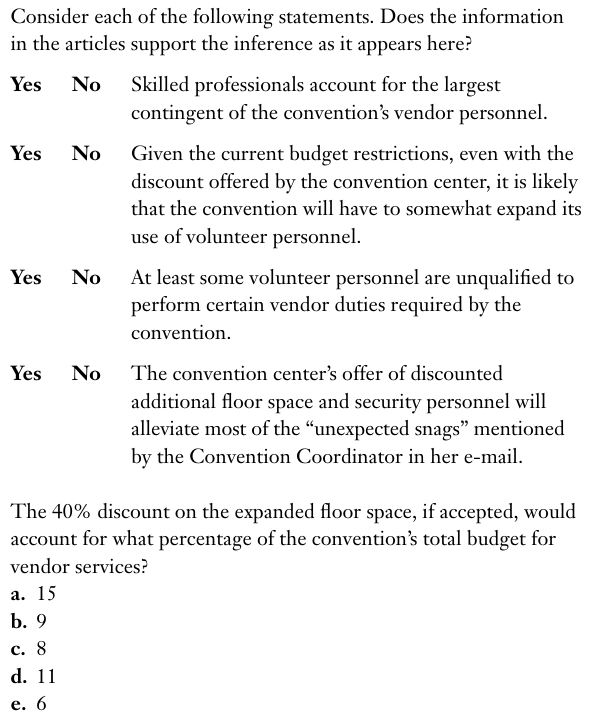
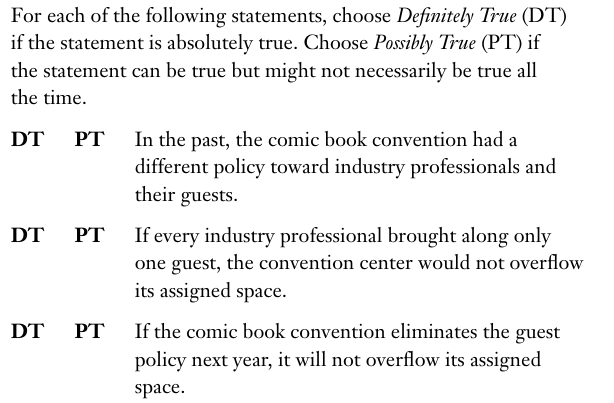
Practice Answer Set 1
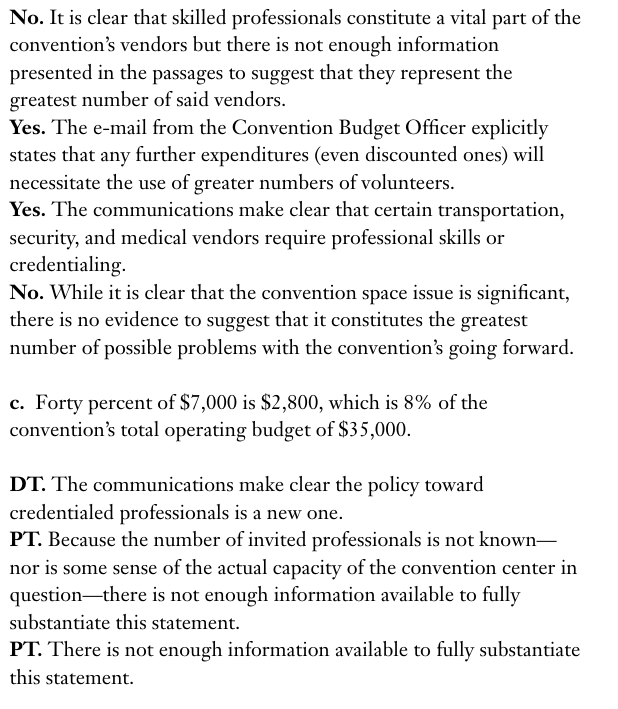
Practice Question Set 2
Use the following to answer questions
Internal Communication from Sports League
We appear to have reached a serious impasse with the umpires’ union regarding their contract demands. Besides salary and cost-of-living increases amounting to 10% distributed evenly over four years, a refine ment of the league’s full-time umpire hiring policy, and improved physical fitness regimes and assessments, the union is demanding that our league continue to offer a defined-contribution retirement plan to all currently active umpires through the year 2021. Frankly, we find this latter demand unacceptable, as it is a benefit enjoyed only by the umpires. We may need to temporarily vacate certain standing policies related to umpires if we are to have replacements on the field in time for the regular-season opener.
Internal Communication from Umpires’ Union
We appear to have reached a serious impasse regarding our demands from the sports league. First, the league is demanding that we permit the hiring of a greater number of full-time umpires. And, though the league has agreed in principle to our salary demands (though only to a six percent cost of-living increase distributed evenly over four years), the issue of the pen sion plan remains, with the league insisting that we accept a more conventional 401k plan. The cost of the current plan, remarkably, is a mere $3 million per year and therefore well within the league’s current ability to fulfill. Still, there has been no significant agreement on this front. We believe that the league will move soon to hire replacement umpires in hopes of having them on the field for the regular-season opener in two weeks.
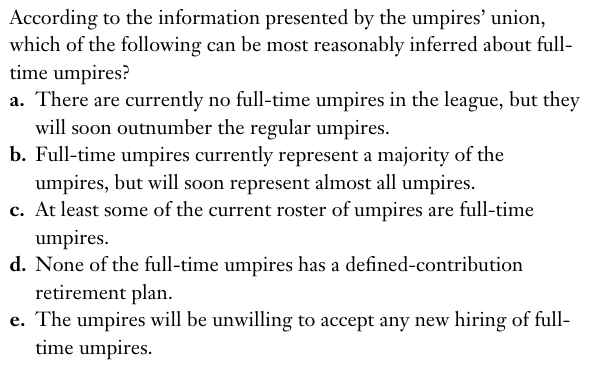
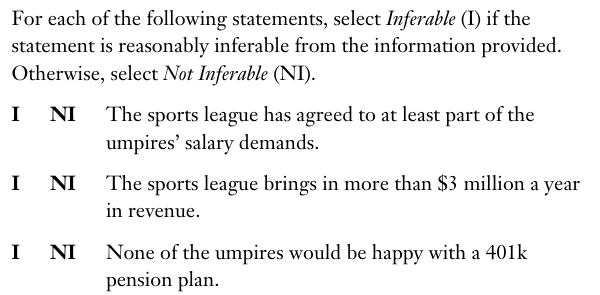
Practice Answer Set 2
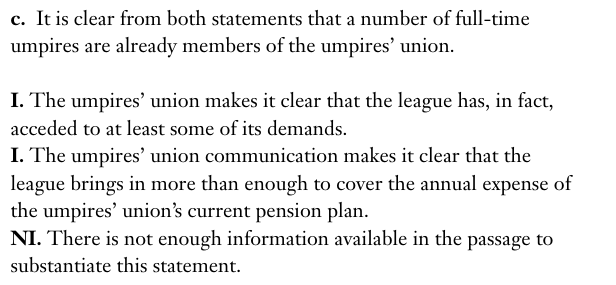
Conclusion
Let’s be honest — at first glance, Multi-Source Reasoning feels like GMAT's way of asking, “How well do you multi-task while mildly panicking?” But by now, you’ve learned that it’s not about panic — it’s about planning.
Research from GMAC shows that strong performance in Data Insights correlates with better success in MBA programs, especially in courses requiring analytical decision-making. That’s right – these questions are a preview of your B-school reality!
So, embrace the tabs. Love the logic. Laugh at the absurdity of it all. With smart strategies, good time management, and a little humor, you’ll turn confusion into confidence.
Remember: You don’t have to read everything. Just the right things. And if MSR questions were a gym for your brain, congratulations — you’re getting ripped.
Now go on, future MBA — open those tabs and start solving like a boss.
